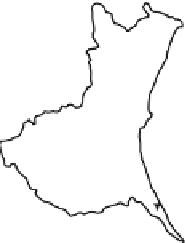Geography Reference
In-Depth Information
Fig. 3.24
General view of the Toyosato district, Tsukuba City, 1995
3.2.3.1
Spatial Characteristics of the
Kanamura
Faith
in the Toyosato District
(1) The Spatial Characteristics of the
Kanamura
Faith, 1930-1940
Table
3.3
shows a record of prayers for rain in 1931 and 1932 in Toyosato
district. In those days, the village and district heads prayed to
Kanamura
for
rain if there was little rainfall in July and August. The data on the records
include the name of the village, its head, and the district; cultivated fi elds dam-
aged by dry weather; total homes; and the distance and direction from Kanamura.
Delegate visitors brought prayers to Kanamura with their stamps and asked a
Kanamura
priest to pray for rain. The priest then gave them holy water drawn
from a well at Kanamura and in a bamboo bottle. The visitors took the holy
water back to their village as soon as possible, and the villagers put the holy
water in a sacred space, such as a tutelary shrine, chanted Shinto prayers, and
offered sacred sake and food. Some holy water mixed with normal water was
handed to each villager and sprinkled on the cultivated fi elds. Custom dictated
that the bottle for holy water was returned to
Kanamura
within a week. There
were taboos regarding the prayer for rain. For example, women were not
allowed to get close to the sacred space, and people were not allowed to talk, or
eat eggs or bamboo shoots. Judging by the existence of these taboos, it is clear
that the prayer for rain was common.

















































































Search WWH ::

Custom Search